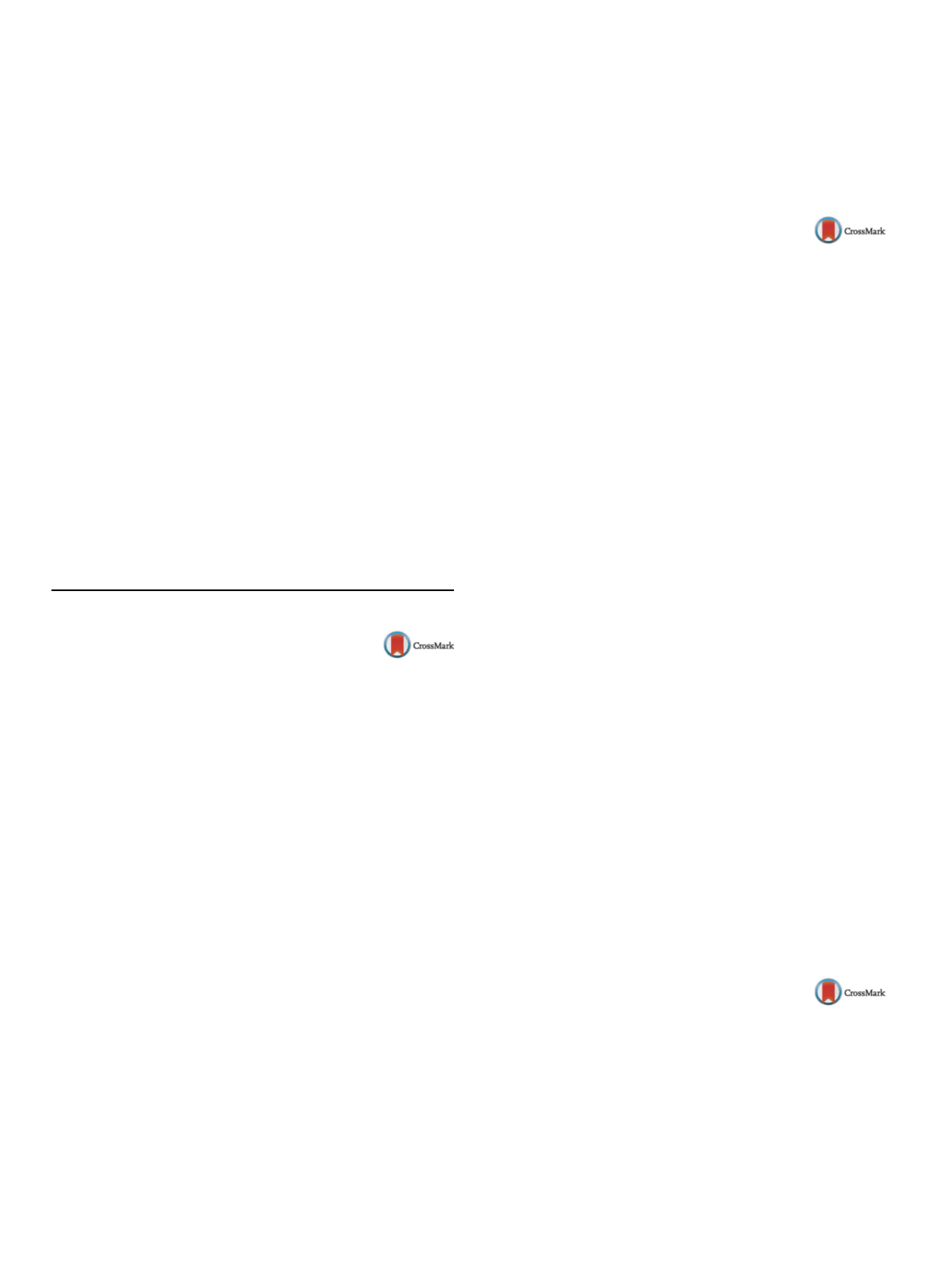

S392
25th European congress of psychiatry / European Psychiatry 41S (2017) S365–S404
Objective
To study the association between smoking and TD
induced by antipsychotics in outpatients with schizophrenia.
Methods
This was a cross-sectional study. It involved 89 patients
suffering from schizophrenia, followed-up in outpatient psychi-
atry unit at Hédi Chaker university hospital in Sfax in Tunisia,
between April and May 2016. We looked for TD in according to
DSM-IV-R criteria. The intensity of TDwas assessedwith the Abnor-
mal Involuntary Movement Scale (AIMS) and the level of nicotine
dependence with the Fagerström Test for Nicotine Dependence
(FTND).
Results
The prevalence of smoking in patients with schizophre-
nia was 69.6%. Of these, 54.8% had a high or very high degree of
nicotine dependence. The prevalence of TD was 33.7%. The AIMS
average score was 12.13
±
5.6 with extremes ranging from 3 to 26.
TD was correlated with tobacco consumption (
P
= 0.003), the aver-
age number of smoked cigarettes (43.7 vs. 33.8;
P
= 0.004) and the
Fagerström average score (7.2 vs. 6.1;
P
= 0.012).
Conclusion
The results of this study showed a correlation
between the amount of smoking and severity of TD in patients with
schizophrenia. The nature of the relationship between smoking and
TD needs to be clarified through an experimental study.
Disclosure of interest
The authors have not supplied their decla-
ration of competing interest.
http://dx.doi.org/10.1016/j.eurpsy.2017.02.442e-Poster Walk: Substance related and addictive
disorders – Part 2
EW0829
Leptin and ghrelin levels in
alcohol-dependent patients and their
relationship with withdrawal and
craving
S. Mehta
1 ,∗
, A . Baruah
2 , D.Chetia
2 , S. Das
2 , P. Avinash
21
SMI, Psychiatry, Dehradun, India
2
LGBRIMH, Psychiatry, Tezpur, India
∗
Corresponding author.
Introduction
Association between leptin and ghrelin plasma lev-
els and alcohol craving have been found in few studies but they
have failed to differentiate this correlationwith alcohol withdrawal
state.
Objectives
To research this correlation in a different population
and to study this correlation with respect to hyper-excitable state
of alcohol withdrawal.
Aim
To study levels of leptin and ghrelin in relation with alcohol
withdrawal and craving.
Methods
Twenty-five indoor patients fulfilling the alcohol
dependence criteria were assessed for alcohol withdrawal symp-
toms and craving. Leptin and ghrelin levels were measured on 1st
day, @ the end of 1st week, @ the end of 3rd week of stopping
alcohol. Withdrawal was assessed using CIWA-A at day 1 and day
7, craving was assessed using PENN’s scale of craving at the end
of week 1 and week 3. Control group consisted of 15 first-degree
relatives not taking alcohol.
Results
It was found that leptin [
t
(38) = 2.95,
P
= 0.005] and
ghrelin [
t
(38) = 2.56,
P
= 0.015] were significantly higher in
alcohol-dependent patients. Levels of hormones had no signifi-
cant correlation with alcohol withdrawal scores but had positive
correlation with craving scores after abstinence.
Conclusions
Leptin and ghrelin, known for balancing the energy
homeostasis of body, also seem to play a role in pathways of drug
dependence and craving. This relation is independent of stress
hormone axis as leptin and ghrelin levels are not correlated with
withdrawal scores, which is an indicator of stress hormone axis
activation during alcohol withdrawal.
Disclosure of interest
The authors have not supplied their decla-
ration of competing interest.
http://dx.doi.org/10.1016/j.eurpsy.2017.02.443EW0830
Affective temperaments in medical
students using prescription
stimulants for neuroenhancement
L. Mineo
1 ,∗
, Y . Sarraf
2 , S. Hanauer
2 , D.Patel
2 , C. Ingram
2 ,L. Montemagno
1 , C. Concerto
3 , F. Battaglia
31
University of Catania, Department of Clinical and Experimental
Medicine, Psychiatry Unit, Catania, Italy
2
New York College of Podiatric Medicine, Department of Preclinical
Sciences, New York, USA
3
Seton Hall University, Department of Interprofessional Health
Sciences and Health Administration, South Orange, USA
∗
Corresponding author.
Introduction
The non-medical use of prescription stimulants
(NMUPS) is a common habit among American college students; It
refers to the use of stimulant medications by students who do not
qualify for prescription or in higher quantities or manners other
than prescribed in order to improve their academic performance.
To the best of our knowledge, no studies have examined the role
of specific affective, biologically determined and inherited traits
that might predict misuse of stimulants for neuroenhancement in
graduate education.
Aim
To examine the role for individual temperament traits on
non-medical use of prescription stimulants (NMUPS) in medical
college students.
Methods
We investigated 181 students using the short form of
the Temperament Evaluation of the Memphis, Pisa, Paris and San
Diego Auto-questionnaire (TEMPS-A). Furthermore, we assessed
the association of demographic variables and health risk behaviors
(drinking, smoking, use other illicit drugs) with NMUPS. Predictors
were investigated using logistic regression.
Results
The prevalence of NMUPS was 30.06% with 7.1% users
being previously diagnosed with ADHD. NMUPS users had higher
scores on the hyperthymic scale. Themain reason for takingNMUPS
was to “Increase ability to stay alert during studying” (80.1%) fol-
lowed by “Allow studying for longer periods of time” (19.9%). The
hyperthymic temperament score and being a user of other illicit
drugs increased the odds of becoming NMUPS.
Conclusions
Our results suggest that personality profiles can be
used to identify students with an increased risk for NMUPS for early
personalized counseling and behavioral intervention based on their
temperament profile.
Disclosure of interest
The authors have not supplied their decla-
ration of competing interest.
http://dx.doi.org/10.1016/j.eurpsy.2017.02.444EW0831
Impulsivity and pathological
gambling: An Italian study
F. Mucci
∗
, D.Marazziti , S. Baroni , A. Piccinni
Università di Pisa, Dipartimento di Medicina Clinica e Sperimentale,
Pisa, Italy
∗
Corresponding author.
Introduction
Pathological gambling (PG) is a behavioral addic-
tive disorder characterized by persistent and problematic gambling
behaviors, in presence of impairment of self-regulation and impul-
sivity. Impulsivity is widely supported by literature in developing
and maintaining addictive behaviors and PG.


















